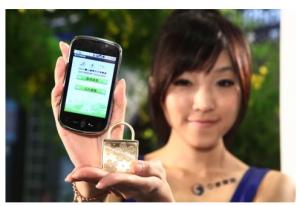Taiwanese Telco Unveils Its NFC-Bluetooth Device

Chunghwa Telecom has unveiled its NFC-Bluetooth "dongle," a large key ring designed to give NFC functionality to certain smartphones via a Bluetooth connection.
The telco, Taiwan’s largest, is having at least 10,000 of the devices produced, which it will showcase at a six-month expo to be held in Taiwan’s capital city, Taipei, beginning next month. The project is likely to be the first use of an NFC bridge technology beyond the trial stage.
The devices, shaped like a padlock, come embedded with both NFC and Bluetooth chips. Users will be able to tap the devices to make purchases, pay transit fares and also to read tags to view exhibit information at the expo and download coupons. The dongles will communicate via Bluetooth with apps on subscribers’ mobile phones, mainly those supporting Google’s Android operating system. NFC Times reported on the project last month.
A source with the mobile operator revealed the names of the banks that will issue the MasterCard PayPass payment applications to be stored on secure chips in the devices–Taishin Bank and E.Sun Bank. Char-Shin Miou, project manager for NFC Technology and IC card applications for Chunghwa Telecom Laboratories, also told NFC Times the secure chip will store the icash-EasyCard stored-value application. The application can be used to pay metro and bus fares in Taipei and also make purchases at more than 4,000 7-Eleven convenience stores in Taiwan, along with perhaps 5,000 or 6,000 other stores, including Starbucks coffee shops. The application, now used on contactless cards, earns loyalty points at the 7-Eleven stores.
Chunghwa Telecom received some government funding for the project. It is putting the technology, which it designed in-house, on display at the large 2010 Taipei International Flora Expo, which is scheduled to begin its six-month run in November.
Consumers will have to pay for the device, which they could hang on their bags. The padlock-shaped key ring features a floral design, which Miou said comes encrusted with crystal.
The NFC-Bluetooth dongles also come with some challenges, including a requirement for software to be loaded on each handset supporting the phone operating system. The communication between the dongle and phone also relies on the Bluetooth application-programming interfaces, or APIs, and these differ according to the phone’s operating system. Many models, such as Apple’s iPhone, do not work with the devices.
More NFC bridge or alternative technologies, such as contactless microSD cards and SIMs with flexible antennas, are expected on the market next year, along with full NFC phones.












